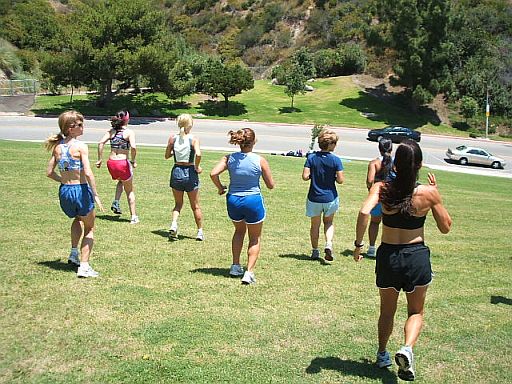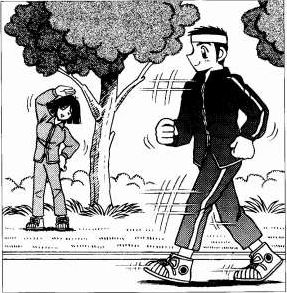 Many
people in Japan practice walking or running backward. In that way, it
burns several times more calories than traditional way of jogging
exercise.
Many
people in Japan practice walking or running backward. In that way, it
burns several times more calories than traditional way of jogging
exercise.Aside from this advantage, your balance increases, meaning vision and hearing powers increase, too. It is because you do not have eyes behind you, so the senses pick up the needs.
When I was a small boy in 1940s, I grown up with my grandparents at our mountain farm in Mt. Koya (also means Takano-san in Japanese) near Wakayama prefecture in Japan, planting various vegetables and trees everyday.
My grandparents had to bend their bodies backward in face-up position, whenever they finished planting a few plants. Stretching the body is equivalent to backward exercise vs. your physical work.

I can remember what my grandparents told me as if it was just yesterday: "To extend your life span with healthy condition physically and mentally, do stretching exercises backwards like I do."
Yes, I saw my parents and grandparents did backward exercises everyday. In fact, my grandparents lived up to 98 years old with healthy condition. My father also lived up to 98 years old, and my mother lived up to 97 years old.
Backward walking is practiced since long time ago especially among elderly people as a part of daily exercise to be mentally and physically fit. This kind of practice is also called retro-exercise.
It's a reasonable and a good way to incorporate another means of exercise to lessen the stress on any given part of the body. This kind of backward movement especially running strengthens the heart, lungs, muscles and joints. I have been recommending backward exercise to our friends from the last 40 years.
It's good for the hips, legs, and trunk. When you go backwards, your stomach will work out like your back and creates a nice reaction for your abdominals. Putting it in reverse for a while is a pretty good deal.

Also, 100 steps backward walking is equivalent to 1,000 steps conventional walking. Doctors recommend us to walk or do jogging everyday as a part of exercise. But it is too time-consuming for busy businesspeople.
A physical exerciser told me that 100 steps backward walking is equivalent to 1,000 steps conventional walking. 1,000 steps walking take a half day work. Many have no such precious time to waste just for jogging or walking especially in the morning. It is also hard to continue everyday.
For backward walking, an important point is not to bend the knee, but it is recommended to try to keep your feet straight or in stretched position. Backward walking does not require long distance, which means you can do it anywhere, at your backyard or at the top of your office building during snack time.
The drawback, of course, is a lack of hindsight. We recommend that newcomers to backward walking or running do it gradually on a track to avoid potholes, signs, cars and other hazards.
Let's walk backward and get physically and mentally healthy.
Junji Takano is a Japanese health researcher involved in investigating the cause of many dreadful diseases. In 1968, he invented PYRO-ENERGEN, the first electrostatic therapy device for electromedicine that effectively eradicates viral diseases, cancer, and diseases of unknown cause.
Click here to find out more: http://www.pyroenergen.com/
Free health newsletter: http://www.pyroenergen.com/newslett
###
Hooper TL et al did find that heart rate and oxygen
consumption was 17% to 20% higher for backward walking than for forward walking
Backward Walking & Lower-Back Pain.
In
a small study of college athletes, Janet Dufek and colleagues found that
participants who engaged in backward walking for several weeks experienced a
significant reduction in their lower-back pain.
Janet had also collaborated with Barry Bates of the
University of Oregon on an undated opinion paper, Forward and Backward Locomotion: Understanding the
Benefits, Janet Dufek that showed that backward
walking and running improved cardiovascular function, improved muscle balance,
and facilitated neuro-muscular function and balance and proprioception.
References
Hooper
TL, Dunn DM, Props JE, Bruce BA, Sawyer SF, Daniel JA. The effects of graded forward and backward walking on heart rate and
oxygen consumption. J Orthop Sports
Phys Ther. 2004 Feb;34(2):65-71.
Dufek
JS, House AJ, Mangus BC, Melcher GG, Mercer JA. Backward Walking: A Possible Active Exercise for Low Back Pain
Reduction and Enhanced Function in Athletes. Journal
of Exercise Physiology online
2011;14(1):17-26.


No comments:
Post a Comment